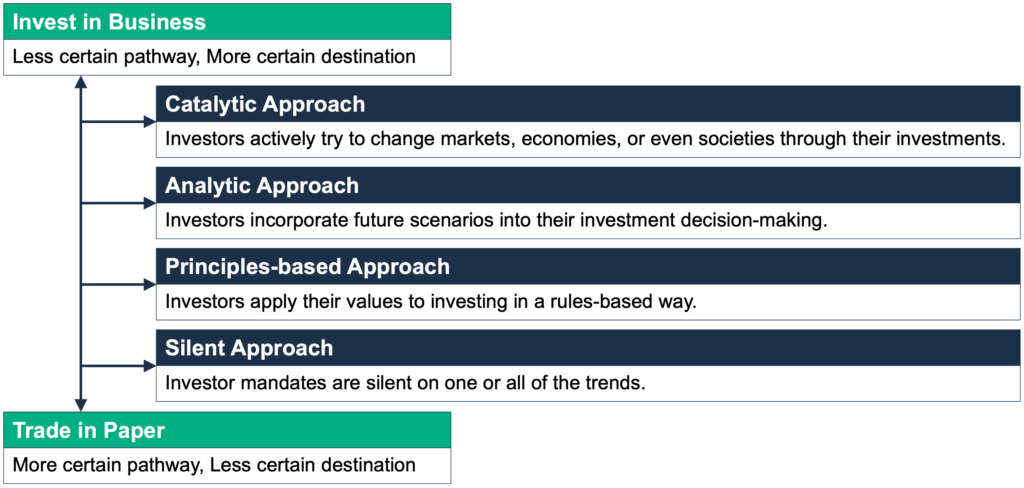
Last month in Madrid, the International Forum of Sovereign Wealth Funds (IFSWF) invited FCLTGlobal to its annual meeting to lead a discussion session on navigating disruptive megatrends.

Last month in Madrid, the International Forum of Sovereign Wealth Funds (IFSWF) invited FCLTGlobal to its annual meeting to lead a discussion session on navigating disruptive megatrends.
Almost two hundred participants, representing sovereign wealth funds from around the world, engaged in this discussion, describing the specific trends they are experiencing and which new tools they need to navigate these circumstances successfully.
As first laid out in Decarbonizing Long-Term Portfolios, there are four distinct approaches to investing within the context of disruptive trends that long-term investors can choose from:

“Silent and principled is how everyone is currently operating, making change hard… It can be productive to shift the status quo.”
The conversation in Madrid reinforced that catalytic investors can influence markets, economies, and societies so that they can remain resilient through – and find opportunity in – long-term trends. One important way they do this is by investing in businesses more than “trading in paper”: focusing on the resiliency of businesses rather than the short-term rising and falling of stocks and bonds.
“I think it’s too risky not to adopt a catalytic approach… If we don’t get the long-term savings funds [involved as catalysts], we fail as a planet.”
Long-term trends (climate change, inclusive economic development, shifting global demographics, to name a few) and recent market shifts (such as a rise in geopolitical instability, the importance of data security, and advances in AI and other areas of fintech) present sovereign wealth funds, as well as their asset managers and portfolio companies, with constantly evolving opportunities and challenges.
When is it the right time to be catalytic? The group in Madrid coalesced around three key factors – responsibility, risk, and returns.
| Possible tools to invest catalytically for the long term | |
|---|---|
| Strategic: | Tactical: |
| Co-investment partnerships | Filtering and Prioritization criteria |
| High-conviction strategies | Simplification tools (eg. checklists) |
| Leading by example | Conversation Guides: which questions, who to ask, and when |
Even when the circumstances are right for taking a catalytic approach, sovereign wealth funds distinguish between that approach and traditional activism. Preserving a light touch is part of being a catalyst; investors taking this approach avoid a deep intervention in a company’s management and maintain the equilibrium between influence and autonomy that often underpins long-term relationships between investors and companies.
The catalytic approach is inherently long term, as it demands a level of patience through high-volatility scenarios, a thirst for innovation, and active engagement to influence today’s asset allocation for the sake of future outcomes. Used appropriately, it can be an effective, transformational methodology against modern obstacles – and one that the funds represented in Madrid are well-positioned to adopt.

Climate | Report
11 April 2022 - An Adaptable, Top-Down Approach to Addressing Climate Change in Investment Portfolios

Risk and Resilience | In the News
20 October 2022 - Many of today’s investors have been drilled in the basics of return and risk – or volatility, the traditional definition of “risk.” We know that there is no return without some risk, and we evaluate how much risk is palatable given our objectives. In years past, these two “Rs” were sufficient to succeed. But today’s investors know that isn’t the case anymore, and a third area is necessary to outperform in the future. The third R is resilience.

Risk and Resilience | Article
27 March 2023 - “Do we mean to hold businesses or paper?” The question is one of the most compelling to emerge from Davos this year because its implications are so provocative for long-term institutions.